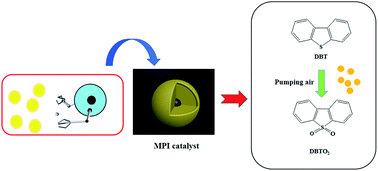The quantity and type of ILs needed to form magnetic-heteropolyacid mesoporous catalysts and their highly performance for DBT removal
Abstract
Magnetic-heteropolyacid mesoporous catalysts, formed through the linkage of an ionic liquid, a magnetic Fe3O4@MCM-41 support, and a heteropolyacid, have been prepared and used in the deep oxidative desulfurization process. When various molar ratios of ionic liquid were introduced into the system, viscosity was shown to be an important factor in determining the ODS efficiency, and 0.4 mL of ionic liquid (MPI-0.4) could achieve the best effects. Also, different types of ionic liquid, with the main difference being the length of the carbon chain, showed varying desulfurization effects. With oxygen in the air as the oxidant, MPI-c (ionic liquid carbon chain length n = 14) proved to demonstrate the perfect desulfurization efficiency in the DBT removal process, not only in model oil but also in real diesel, reaching a removal rate of up to 100% within 60 min. Moreover, it could be recycled at least 15 times under simple external magnetic field separation with no obvious decrease in catalytic performance.



 Please wait while we load your content...
Please wait while we load your content...